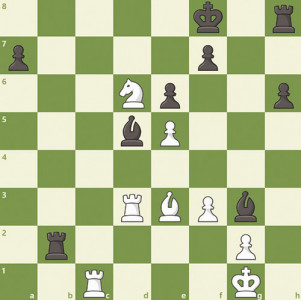
In chess, Overloading the Defender is a tactic in which a defensive piece is faced with another threat which it cannot guard against while still fulfilling its original defensive purpose. This concept is demonstrated in Figure 1, in which white is down a full rook but can force checkmate in three moves with the move queen to d4, overloading the key defensive piece in the black position: the d8 rook. queen to d4 threatens checkmate on g7 and to take the rook on d8, overloading its defensive capabilities as it cannot defend both the d4 square and the backrank. If the rook takes the queen on d4, then it stops guarding the backrank, so rook to e8 is checkmate. If pawn to f6 to protect against queen takes g7 checkmate, the queen can simply capture the rook on d8 and after king to f7, queen to e8 is checkmate.
Figure 2 is from a game in the 1985 World Championship between Grandmasters Garry Kasparov with the white pieces and Anatoly Karpov with black. The intense rivalry between the two players began in the world championship match the prior year, which was terminated by the International Chess Federation (FIDE) and continued into the 1985 match, which Kasparov ultimately won. In the position displayed above, Kasparov began with 1. d5, trading off his isolated pawn and breaking at black’s center. 1… Nxd5 2. Nxd5 Bxg3, a zwischenzug or in-between move that first trades off white’s powerful bishop on g3 before recapturing the knight on d5. After 3. hxg3 exd5 4. Bxd5, the players complete a massive exchange of pieces and opening of the center, and transition to positional play that adapts to the significant change in the position. Therefore, Karpov played 4… Qf6, developing the queen to an active square where it attacks the b2 pawn and applies pressure to both sides of the board. Kasparov developed his own queen to an active square with 5. Qa4 so that if black takes on b2, the c6 knight is left hanging. 5… Rfd8 6. Rcd1 Rd7 and both sides centralize their rooks to take further control of the center. 7. Qg4 attacks the d7 rook and Karpov defends with 7… Rcd8, a seemingly normal move that doubles his rooks on the d file and protects the d7 rook but actually blunders the game to the overloading tactic 8. Qxd7. Qxd7 overloads d8 rook which cannot defend both the d7 rook and the backrank due to the tactical play against black’s king that exists after 8… Rxd7. Because of the open backrank, white has 9. Re8+ 9… Kh7 10. Be4+, a discovered attack that wins the d7 rook.

Here, Karpov resigned because white is completely winning after 10… g6 11. Rxd7 Ba6 as white can play 12. Bxc6. The black queen is overloaded because it cannot defend both the c6 knight and Rxf7 checkmate.
Figure 3 is from a game between World Champion Boris Spassky with white and Grandmaster Bent Larson with black at the Palma de Mallorca in 1969. Black is actually up a pawn but white wins by overloading the f7 pawn,which both defends the e6 rook and prevents white’s f6 pawn from promoting, with the sacrifice: Queen takes e6. Larson resigned here because after the f7 pawn captures the queen on e6, it no longer holds the f6 pawn in place. This allows white to push the pawn to f7 after which black simply cannot prevent white’s f pawn from promoting to a queen.
The position displayed in Figure 4 is from a game between Grandmasters Yury Shulman with the white pieces and Loek van Wely with black at the 2009 Foxwoods Open. Black has an additional pawn on the a file, however, white attains a winning advantage by overloading black’s e6 pawn which defends both the d5 bishop and the f5 square with the move Rook takes d5. The exchange sacrifice wins for white because after black captures back on d5 with the pawn, white’s knight can then move to f5, attacking black’s bishop on g3 and threatening rook to c8 checkmate. Black has to protect against checkmate and white can then capture the hanging bishop on g3. In the resulting endgame, white has two pieces for a rook, a winning advantage as the two pieces have greater attacking and defending capabilities than a singular rook.

Ethan Feder is a junior at Yeshivat Frisch, a chess enthusiast and player. The goal of his column is to teach and discuss chess concepts through example positions, high-level games and relevant puzzles, along with explanations. Feel free to contact him with any questions, suggestions or comments at [email protected].













